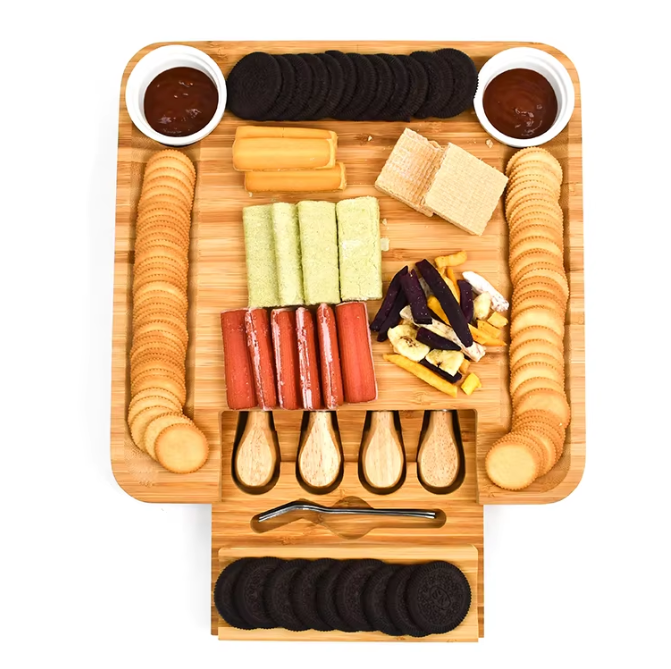How Wood Porosity Affects Food Flavor on Charcuterie Boards
Understanding Porosity and Flavor Absorption
The porosity of wood plays a big role in how a charcuterie board interacts with different foods. Basically, wood has tiny spaces throughout its structure that let air and moisture move through it. These little gaps affect whether the wood soaks up flavors from what gets placed on it, like oils and acidic substances. Put something really flavorful on porous wood and watch what happens – those oils just sink right in. That's why many people notice their boards still smell like last week's onion or garlic long after they've wiped them clean. The science behind it? Food chemicals react with the actual wood fibers, which explains why certain smells stick around. For anyone who uses these boards regularly, understanding this helps explain why some woods work better than others for serving particular types of food.
Different kinds of wood have very different porosity levels, which makes a big difference when it comes to food contact surfaces. Take maple and walnut for instance these woods tend to be less porous so they don't soak up much flavor from whatever gets placed on them, which is why many people prefer them for charcuterie boards. On the flip side, some woods are really porous and can actually trap flavors, sometimes even letting one taste mix into another. A recent research paper pointed out how important this porosity factor really is when preparing food presentations. Knowing about these properties helps chefs and home cooks pick the right wood for their boards, ensuring that each bite stays true to its original flavor while still looking good on the table.
Case Studies: When Wood Alters Taste
Looking at actual case studies shows some interesting things about how different woods affect food flavors. When chefs experiment with woods like olive and cherry, they often find these woods add those subtle earthy flavors to dry cured meats that make people really enjoy their meals more. Chef John Storm told stories about times when using the wrong kind of wood messed up dishes completely. He mentioned one incident where cheese ended up tasting like last night's smoked brisket because someone didn't clean the smoker properly between batches. These kinds of mishaps highlight why knowing which woods work best with what foods matters so much in cooking.
Looking at those fancy charcuterie boards served in upscale restaurants reveals something interesting many chefs actually pick certain kinds of wood on purpose to go well with their dishes. The pros say folks tend to catch onto this stuff and really appreciate when the board matches what they're eating instead of clashing with it. Some restaurant owners tell stories about how regulars get pretty particular about their boards. They usually want ones made from wood that doesn't soak up smells, especially when serving all sorts of different foods together so nothing gets mixed up in taste.
Hence, choosing the right wood can significantly affect not only the taste but also the overall dining experience. This underscores the importance of thoughtful wood selection in culinary settings, where the goal is to deliver not just food but a memorable and tasteful experience.
Best Wood Types for Neutral Food Flavor Preservation
Maple: The Classic Choice
Maple wood stands out as a top choice for charcuterie boards because it doesn't absorb much moisture and has a taste that won't interfere with what's placed on it. The tight grain structure means meats, cheeses, and other items don't pick up unwanted flavors from the board itself. Maple also happens to be pretty tough stuff. It holds up well when knives are dragged across it, so people can actually prepare their meals right on the same board they're serving from without worrying about damage. Another plus point? These boards resist those annoying little scratches that accumulate over time. Most folks find that just giving them a good rinse after use works fine, though some prefer to rub in a bit of mineral oil every now and then to keep things looking fresh. This basic care helps ensure whatever gets served stays tasting exactly how it should be.
Cherry: Elegance Meets Functionality
Cherry wood really catches the eye and works great for serving food on charcuterie boards. It has just the right amount of pores in the grain so it doesn't absorb too much flavor from whatever gets placed on it, which means the meat and cheese can shine without competing against strong wood tastes. The color ranges from deep reds to warm browns give any table setup a classy vibe that feels inviting at dinner parties or weekend gatherings. If someone wants their board to stay looking good and performing well over time, they should oil it regularly. A few drops of mineral oil every now and then keeps the surface protected and maintains those neutral flavor properties. Cherry wood boards tend to become conversation starters at events, combining practicality with visual appeal that makes them stand out among other serving options.
Walnut: Durable and Flavor-Safe
People love using walnut wood for charcuterie boards because it lasts forever and doesn't soak up weird flavors. The wood itself is pretty tough stuff, so these boards stay in good shape for years. Plus, who can resist those dark, handsome colors that look so nice on any table? Walnut just happens to be safe for food contact too, which means all those fancy cheeses and meats won't pick up strange tastes from the board itself. Most folks who own walnut boards rave about how easy they are to clean up after a party, and nobody complains about lingering smells either. That's why walnut keeps showing up again and again at gatherings where presentation matters as much as taste.
Bamboo: Eco-Friendly Option
Bamboo makes sense as a material for charcuterie boards because it ticks multiple boxes when it comes to being green and lasting long enough to justify the purchase. What sets bamboo apart from other woods is how non-porous it is, so foods don't absorb into the surface and alter their natural flavors. This quality alone has made bamboo boards increasingly popular among home cooks who want something that won't stain easily or retain strong smells after serving cheese, meats, or fruits. The wood itself holds up really well over time too, which means these boards can handle regular kitchen wear and tear while still looking good on display. For anyone trying to balance eco concerns with kitchen decor, bamboo offers that sweet spot where sustainability meets contemporary design without sacrificing everyday usefulness.
Woods That May Impart Unwanted Tastes to Your Spread
Softwoods to Steer Clear Of
Softwoods may be easy to find at hardware stores but they really aren't good choices for cutting boards or anything else used in food prep. The reason? They have all those resins inside that will definitely mess with whatever food touches them. Most softwoods come packed with oils and sap that soak right into whatever gets cut on them, changing how things taste. And there's actually a health concern too since some of those resin compounds can become toxic when mixed with food stuffs. Think about it this way: anyone who's ever worked with pine knows how strong that smell is, and cedar and fir aren't much better. These woods tend to leave behind an unmistakable wood taste that ruins delicate dishes like cheese boards or charcuterie spreads. Want to tell if something is softwood? Check out the grain first. Softwoods usually have straighter lines and lighter coloring compared to hardwoods. Plus they smell distinctly woody and sometimes even piney. So when shopping for cutting surfaces or utensils meant for kitchen use, always go for hardwood options instead. This simple switch makes a big difference in both taste quality and overall safety.
High-Porosity Woods and Their Risks
Wood that's really porous isn't great for cutting boards or food prep because it soaks up smells and tastes way too much. People who've used these kinds of boards know how frustrating it gets when leftover garlic or fishy odors stick around even after cleaning. The bigger problem though? Those same tiny holes where the wood drinks in flavors also become hiding spots for bad bacteria and mold growth. Health experts generally advise against using things like cork or oak for charcuterie boards specifically because of this issue. Over time, food prepared on these surfaces tends to get contaminated, which obviously isn't good for anyone eating it. That's why many chefs and home cooks prefer woods that don't absorb so much stuff. They want something that keeps its own character while being easy to clean properly, ensuring both safety and better tasting meals at the table.
Essential Maintenance Tips to Prevent Flavor Cross-Contamination
Proper Cleaning Techniques
Keeping wooden charcuterie boards free from lingering flavors really depends on how they get cleaned. Wood surfaces can be pretty sensitive, so going easy on them makes sense. After using these boards, a simple wipe down with just a damp cloth usually works fine. For those times when things get stickier, mixing some water with vinegar creates a decent cleaning solution. The main thing is staying away from harsh detergents or chemical cleaners that tend to soak into the wood grain. These substances can actually change the way food tastes when placed on the board later. Most folks find that sticking to basic cleaning routines keeps their boards in good shape without compromising the natural wood properties.
1. Frequency: Clean the board after each use.
2. Tools: Use a soft cloth or sponge.
3. Cleaning Agents: Consider mild solutions like water and vinegar.
Tailoring this regular maintenance regimen will ensure the board remains in optimal condition while minimizing cross-flavor contamination.
Seasoning Your Board Correctly
Seasoning your wooden board correctly is vital to preserve flavor neutrality and maintain its integrity. In the context of wooden boards, seasoning involves applying oils to create a protective barrier against moisture and food odors. Regular seasoning helps keep the board from absorbing unwanted flavors. Recommended steps include:
1. Preparation: Clean the board thoroughly before applying oil.
2. Types of Oils: Foodsafe mineral oil is favored for its neutral fragrance.
3. Application Frequency: Season the board monthly for optimal performance.
By regularly seasoning your board, you prevent flavor absorption and extend its lifespan, ensuring that each culinary creation is presented without unwanted taste interference.
Choosing the Right Board: Balancing Material and Practicality
Material selection matters a lot when picking out a good charcuterie board because it affects how nice it looks as well as how useful it actually is during parties. Wood continues to be a go to option thanks to its classic look and all sorts of textures and colors available on the market today. Take maple, cherry, or walnut boards for instance they really elevate any presentation while standing up pretty well against knife marks and cleaning without much hassle. If going green is important, then bamboo makes sense since it's light weight and doesn't harbor bacteria easily. Acacia wood deserves mention too because it handles moisture better than most others, so it lasts longer even after serving cheese and cured meats that tend to drip. Different woods have their own strengths, so finding what works best depends on what kind of events someone typically hosts at home.
Frequently Asked Questions
What is wood porosity and how does it affect flavor absorption?
Wood porosity refers to the microscopic structure of wood that determines its ability to absorb air and moisture. It directly impacts flavor absorption, allowing oils and acids from foods to seep into the board and mingle with previous flavors.
Why are maple and walnut recommended for charcuterie boards?
Maple and walnut have low porosity, meaning they absorb fewer flavors, making them ideal for preserving the original taste of foods served on charcuterie boards.
How can I maintain my wooden charcuterie board to prevent flavor contamination?
Regular cleaning with gentle methods and seasoning with foodsafe mineral oil are recommended to maintain flavor neutrality and protect the board from absorbing unwanted tastes.
Are softwoods suitable for charcuterie boards?
No, softwoods are generally unsuitable due to their resinous nature, which can impart unwanted flavors and pose health risks.
Table of Contents
- How Wood Porosity Affects Food Flavor on Charcuterie Boards
- Best Wood Types for Neutral Food Flavor Preservation
- Woods That May Impart Unwanted Tastes to Your Spread
- Essential Maintenance Tips to Prevent Flavor Cross-Contamination
- Choosing the Right Board: Balancing Material and Practicality
- Frequently Asked Questions



 Home
Home